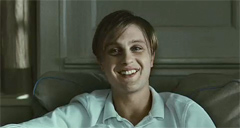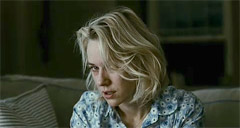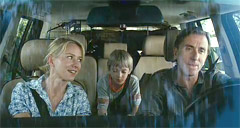In Michael Haneke’s shot-by-shot remake of his 1997 extreme-cinema landmark Funny Games, only the performances and the language have changed. The editing, shot compositions, and, to some degree, the art direction are nearly identical — even the Long Island location doesn’t seem far removed from the European country homes seen in the original. Somehow, though, the English-language version seems easier to take. That may be partly because I long ago had my own argument with the director’s conflation of cinema and reality, rejecting his assertion that indulgence in screen violence is necessarily injurious to the spectator. Haneke has moved on since then, making several films that I regard as something close to masterpieces, so it’s frustrating to see him spending so much time repeating himself. My original review of this one still stands, and is mostly applicable to both versions of the film. But here are some thoughts on the differences between them.
Evil: Now Even More Banal
 Part of the reason Funny Games 1.0 was so unpleasant was not just the
Part of the reason Funny Games 1.0 was so unpleasant was not just the
great naturalism of Susanne Lothar and Ulrich Muhe as the parents, but
the relative anonymity of all the actors, who were largely unknown
outside Germany and Austria. I’m thinking especially of lead psychopath
Arno Frisch. (He had starred in Haneke’s previous Benny’s Video, and it
might have colored my response to Funny Games if I had seen that film
previously, giving me context for the actor’s performance.) In the
first film, Frisch is obviously a surrogate for the director, which
makes his screen presence all the more grating — he comes on like a
smug T.A. lecturing on entry-level literary theory in the professor’s
absence. But Michael Pitt’s low-key line deliveries so lazily evoke the
banality of evil that they help make Funny Games 2.0 substantially
funnier than its predecessor, channeling Haneke’s cranky attitude
through a blandly comic performance while ditching much of Frisch’s
condescension. Frisch had a chilly smile that suggested a deep,
sadistic intellect, but Pitt grins just like the smartest frat boy in
the room. That difference makes the whole film a little bit easier to
take.
I’m Too Sexy For This Role

Naomi Watts brings a new level of blonde-bourgeois pathos to her
bluntly physical performance as lead victim. But she’s also an outright
movie star. Her practiced charisma and screen presence makes a
difference — it gives you something else to think about as you watch,
underscoring the essential artifice of the events transpiring on
screen. She also gives you something to look at — nearly every review
I’ve read has commented on the amount of time Watts spends on screen in
her underwear, having been made to strip by her captors. In the film’s
centerpiece shot, the camera frames a particularly gruesome tableaux
as, in a very long take, a bound and gagged Watts hobbles through the
scene on her knees. (In a nice touch that I didn’t appreciate in the
original version, the first thing she does, despite great difficulty,
is turn off the fucking TV.) The problem is that Watts looks great in
her underwear. She’s powerfully and conventionally sexy, and that
sexiness diffuses the view of the brutality on display. Haneke’s films
tend to be the opposite of erotic, and he almost certainly intended to
make the audience uncomfortable in its voyeurism. But as good as Watts
is, Susanne Lothar was better in the role, in part because her physique
seemed more ordinary.
The Petite Charm of the Bourgeoisie

For the American audience that Haneke maintains he’s always hoped to
reach with this film, the European family in the original was a
somewhat unfamiliar entity. Even in Europe, it seemed like a bit of an
affectation to have a married couple, happy child in tow, playing
name-that-tune with a small stack of classical CDs kept in their car.
On Long Island, it makes them seem downright eccentric. (Shouldn’t this
couple be listening to NPR, or feeding their car stereo from an iPod
set to shuffle play?) It makes me want to have a look at Haneke’s CD
collection — it’s difficult to tell whether he means to be mocking
their presumably bourgeois musical interests, or if he’s just looking
for the most jarring juxtaposition with the chaotic, avant-garde John
Zorn piece (some writers have identified it as “death metal,” which I think is a mistake) that he
uses as a metaphor for the prank-horror that’s about to interrupt their
orderly, tasteful lives. (I very much liked the touch of having one of
the CDs be a Japanese import — talk about money to burn!) But does
Haneke expect the audience to recognize itself on the screen? If so,
this film’s U.S. setting puts it at a disadvantage.
A Model of Taste and Restraint
When Funny Games was originally released, the American horror-movie
market was moribund. Interest in the teen-horror genre wouldn’t be
reignited until the very end of the year, when Scream became a surprise
smash hit over the holidays. More to the point, Eli Roth was still
working as a PA on Private Parts. So Funny Games stands not so much as
a criticism of an audience’s interest in so-called “torture porn,” but
more as a harbinger of it. Still, I was surprised to realize that
almost all of the physical violence in both versions of Funny Games takes place off screen. In the context of the Saw
and Hostel franchises, that decision looks almost quaint. But it’s an
example of the director exercising good taste. He’s been tagged as
hypocritical for using screen violence to score points against
violence, but I think he’s mostly innocent of that, choosing a more
subtle way of putting his audience through the wringer. In today’s
horror-movie climate, Haneke could probably disembowel both adult
characters on screen and still get more of a rise out of the audience
for killing that dog. (Shotgunning the kid on camera might still be
taboo.)
Wait — It’s a Comedy?

The last thing I expected was to walk out of a theater showing Funny
Games with a smile on my face. (Re-reading my original review, I was
surprised to see that I claimed Haneke’s cinema of misery almost had me
laughing the same way I might when Wile E. Coyote gets smashed by a
huge boulder for the umpteenth time in a Chuck Jones cartoon.) But
there’s something about Haneke’s sour approach to the material that
goes all the way over the top and then some. I saw it with a paying
audience (a small matinee crowd in Times Square) that chuckled
appreciatively at Haneke’s Brechtian moments, which did play as black comedy
this time around. I finally understood the movie’s last scene as not
just ruddy nihilism, but rather as outright parody of Hollywood
franchise movies, setting up a here-we-go-again sequel to the original
film. As the credits appear on screen, Haneke’s go-to guy is again John
Zorn, whose crazy avant-jazz composition wails and screeches its way
from wall to multiplex wall, essentially putting the whole film in
quotation marks. The effect is that of sarcasm, and it made me feel
like Haneke himself was admitting a degree of disgust with the movie he
had just made. (Again.) Well, at least we have that in common.

I watched this film today, as it seemed like a version of “A Clockwork Orange”.
I watched, and I felt myself actually feeling something I had never felt before. This horror movie was intelligent! This horror movie was interesting! Hell, this horror movie actually captivated my attention!
This skill in which the director manipulates the audience, is rather like how a cat plays with his food before he eats it. I dangled from and invisible string through every minute of the 100- my heart constantly thrummed in my mouth, my pulse raced to dangerous levels, and at some points I thought that before me was a movie masterpiece. Pitt, in particular impressed me- he reminded me somewhat of Iago from Shakespeare’s “Othello“.
But after some reflection, I realised that this flick ain’t no Shakespeare. Like a table with only three legs, something is missing. The standard of acting is brilliant- but is it too polished? Does it take some of the realism away from the horror? And Naomi Watts is officially hot. What would she be doing with a guy like her husband? They say love is blind…
And the final mind blowing realisation- “Funny Games”, true to it’s name, is funny. The two killers repeatedly cracked me up, and at one moment I had a demonic smile on my face- a smile that I hope I will never recreate. Haneke has created a film that is a lot more subtle with it’s message than “Hostel” or “Saw” and I feel that this works- until the scene where the killing of Brady is rewound. Why, Haneke? Why wreck what so far, has been so good?
And lastly, Haneke is way too patronising. What makes him feel that he is so much better than anybody else? It is human nature to indulge in that we should find despicable, and one of those things in violence and sex on the silver screen. What gives him the right to degrade cinema viewers in such a way? Sorry Mr director, but you’re way to sanctimonious to make this a fully intense viewing.
7/10